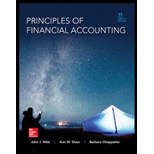
Concept explainers
Prepare journal entries to record the given transactions and events.
Explanation of Solution
Journal entry is a set of economic events which can be measured in monetary terms. These are recorded chronologically and systematically.
Depreciation expense is a non-cash expense, which is recorded on the income statement reflecting the consumption of economic benefits of long-term asset on account of its wear and tear or obsolescence.
Prepare journal entry to record the cost of the van as follows:
| Date | Account Title and Explanation |
Debit ($) |
Credit ($) |
| January 1, 2014 | Equipment | 27,670 | |
| Cash | 27,670 | ||
| (To record the costs of van) |
Table (1)
Working Note:
Calculate the costs of van.
- Equipment is an asset account and it is increased. Therefore debit equipment account.
- Cash is an asset account and it is decreased. Therefore credit cash account.
Prepare journal entry to record the betterment of the van as follows:
| Date | Account Title and Explanation |
Debit ($) |
Credit ($) |
| January 3, 2014 | Equipment | 1,850 | |
| Cash | 1,850 | ||
| (To record the betterment of van) |
Table (2)
- Equipment is an asset account and it is increased. Therefore debit equipment account.
- Cash is an asset account and it is decreased. Therefore credit cash account.
Prepare journal entry to record the depreciation expense as follows:
| Date | Account title and Explanation | Post Ref. |
Debit (In $) |
Credit (In $) |
| December 31, 2014 | Depreciation expense | 5,124 | ||
| | 5,124 | |||
| (To record the depreciation expense) |
Table (3)
Working Note:
Calculate the depreciable cost.
| Amount (In $) | |
| Total original cost | 27,670 |
| Cost of betterment | 1,850 |
| Revised cost of equipment | 29,520 |
| Less: Revised salvage | 3,900 |
| Depreciable Cost | $25,620 |
Table (4)
Calculate the depreciation expense for the year 2014 after January 3rd betterment.
- Depreciation expense is a component of
retained earnings . It decreases the retained earnings. Thus, depreciation expense is debited. - Accumulated depreciation is a contra asset which decreases the value of the asset. Increase in accumulated depreciation decreases the asset’s value. Thus, accumulated depreciation on equipment is credited.
Prepare journal entry to record the extraordinary repair on van as follows:
| Date | Account Title and Explanation |
Debit ($) |
Credit ($) |
| January 1, 2015 | Equipment | 2,064 | |
| Cash | 2,064 | ||
| (To record the extraordinary repair on van) |
Table (5)
- Equipment is an asset account and it is increased. Therefore debit equipment account.
- Cash is an asset account and it is decreased. Therefore credit cash account.
Prepare journal entry to record the ordinary repair on the van as follows:
| Date | Account Title and Explanation |
Debit ($) |
Credit ($) |
| May 10, 2015 | Repairs expense–Equipment | 800 | |
| Cash | 800 | ||
| (To record the betterment of van) |
Table (6)
- Repairs expenses are the components of the
stockholder’s equity. An expense decreases the stockholder’s equity. Thus, repairs expenses account is debited. - Cash is an asset account, and it is decreased. Thus, credit the cash account.
Prepare journal entry to record the depreciation expense as follows:
| Date | Account title and Explanation | Post Ref. |
Debit (In $) |
Credit (In $) |
| December 31, 2015 | Depreciation expense | 3,760 | ||
| Accumulated depreciation | 3,760 | |||
| (To record the depreciation expense) |
Table (7)
Working Note:
Calculate the depreciable cost.
| Amount (In $) | |
| Total original cost | 31,584 |
| Less: Accumulated depreciation | 5,124 |
| Book value | 26,460 |
| Less: Salvage | 3,900 |
| Depreciable Cost | $22,560 |
Table (8)
Calculate the depreciation expense for the year 2015 after January 1st extraordinary repair.
- Depreciation expense is a component of retained earnings. It decreases the retained earnings. Thus, depreciation expense is debited.
- Accumulated depreciation is a contra asset which decreases the value of the asset. Increase in accumulated depreciation decreases the asset’s value. Thus, accumulated depreciation on equipment is credited.
Want to see more full solutions like this?
Chapter 10 Solutions
Principles of Financial Accounting.
- Accounting problem with correctarrow_forwardMila Services collected $278,000 from customers in 2022. Of the amount collected, $134,000 was from services performed in 2021. In addition, Mila performed services worth $189,000 in 2022, which will not be collected until 2023. Mila Services also paid $217,000 for expenses in 2022. Of the amount paid, $156,000 was for expenses incurred on account in 2021. In addition, Mila incurred $172,000 of expenses in 2022, which will not be paid until 2023. Compute 2022 cash-basis net income.arrow_forwardRamos Corporation deposits all cash receipts on the day they are received and makes all cash payment by check.arrow_forward

 AccountingAccountingISBN:9781337272094Author:WARREN, Carl S., Reeve, James M., Duchac, Jonathan E.Publisher:Cengage Learning,
AccountingAccountingISBN:9781337272094Author:WARREN, Carl S., Reeve, James M., Duchac, Jonathan E.Publisher:Cengage Learning, Accounting Information SystemsAccountingISBN:9781337619202Author:Hall, James A.Publisher:Cengage Learning,
Accounting Information SystemsAccountingISBN:9781337619202Author:Hall, James A.Publisher:Cengage Learning, Horngren's Cost Accounting: A Managerial Emphasis...AccountingISBN:9780134475585Author:Srikant M. Datar, Madhav V. RajanPublisher:PEARSON
Horngren's Cost Accounting: A Managerial Emphasis...AccountingISBN:9780134475585Author:Srikant M. Datar, Madhav V. RajanPublisher:PEARSON Intermediate AccountingAccountingISBN:9781259722660Author:J. David Spiceland, Mark W. Nelson, Wayne M ThomasPublisher:McGraw-Hill Education
Intermediate AccountingAccountingISBN:9781259722660Author:J. David Spiceland, Mark W. Nelson, Wayne M ThomasPublisher:McGraw-Hill Education Financial and Managerial AccountingAccountingISBN:9781259726705Author:John J Wild, Ken W. Shaw, Barbara Chiappetta Fundamental Accounting PrinciplesPublisher:McGraw-Hill Education
Financial and Managerial AccountingAccountingISBN:9781259726705Author:John J Wild, Ken W. Shaw, Barbara Chiappetta Fundamental Accounting PrinciplesPublisher:McGraw-Hill Education





